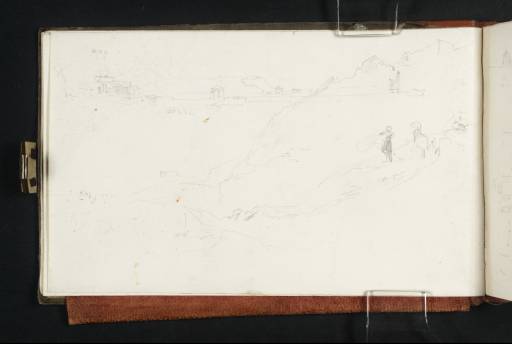Joseph Mallord William Turner Views around Boulogne Harbour, with the Bathing Establishment, and Women on the Cliffs 1825
Image 1 of 2
Joseph Mallord William Turner,
Views around Boulogne Harbour, with the Bathing Establishment, and Women on the Cliffs
1825
Joseph Mallord William Turner 1775–1851
Folio 8 Verso:
Views around Boulogne Harbour, with the Bathing Establishment, and Women on the Cliffs 1825
D19416
Turner Bequest CCXV 8a
Turner Bequest CCXV 8a
Pencil on white wove paper, 113 x 189 mm
Partial watermark ‘Al | 18’
Partial watermark ‘Al | 18’
Accepted by the nation as part of the Turner Bequest 1856
References
1909
A.J. Finberg, A Complete Inventory of the Drawings of the Turner Bequest, London 1909, vol.II, p.662, CCXV 8a, as ‘Scene on cliffs’.
The page comprises two complementary, overlapping prospects from similar viewpoints north of the entrance to Boulogne’s harbour. Along the top, the piers flanking the channel at the mouth of the River Liane are shown towards the right, with the telegraph tower at the end of the western arm, at about the point where the Capitainerie tower now stands on reclaimed land above the Quai de l’Amiral Huguet. To the south-west along the Channel coast, cliffs rise above Le Portel and apparently the outline of Fort de l’Heurt, or offshore rocks; see also folios 15 recto, 16 verso and 80 verso (D19425, D19428, D19537).
Returning to the foreground, the low, arcaded building towards the left is the bathing establishment opened earlier in 18251 above the beach on the near side of the eastern pier, where there may be a few figures. It is now the site of the Nausicaa Centre National de la Mer aquarium, and is shown from the other direction, looking north from the far side of the piers, on folio 14 recto (D19424). The scene is also recorded from directly beside the telegraph tower, looking inland to Boulogne itself (out of sight to the left here), on folios 19 verso–20 recto (D19434–D19435). See also Tate D19327 and D19330 (Turner Bequest CCXIV 245a, 247) in the contemporary Holland sketchbook.
The bathing establishment is shown in detail from a similar angle in an undated watercolour of the period by Captain John Duncan King (1789–1863), inscribed ‘Boulogne sur Mer’ by the artist’s son or daughter (private collection).2 Turner returned to the beach in 1845 with the Boulogne sketchbook (Tate D35416; Turner Bequest CCCLVIII 14).
Below is what appears to be a continuous view of rugged sloping cliffs, looking north to the shallow outline of Fort de l’Heurt’s counterpart, the lost Fort de la Crèche towards Wimereux. Compare two sheets of studies, each with two views of the coast and forts in ink on blue paper, likely from later in the 1820s (Tate D20291–D20292; Turner Bequest CCXXIV 1, 2). The women in the foreground of the present sketch may be airing laundry. Numerous sketches in the present book complement a few on the inland approach and around the harbour and piers in the Holland sketchbook; see under Tate D19319 (Turner Bequest CCXIV 241a), under which the Boulogne’s importance in the recent Napoleonic Wars and its apparent position as the last stop on Turner’s 1825 Continental tour are discussed, with a full listing of the atmospheric watercolour views in the 1845 Boulogne book. Some of the latter can be related to other prospects in the present sketchbook, as discussed in their individual entries.
The views here (see also folios 9 recto–20 recto, 77 verso–78 verso and 79 verso–81 verso; D19417–D19435, D19531–D19533, D19535–D19539) show Turner venturing along the coast to Le Portel (about two miles south-west of the harbour’s mouth) and inland in the opposite direction, as well as in and around the harbour and the walled, elevated old town, or haute ville. The harbour was significantly developed under Napoleon and again subsequently, but it and the surrounding district were severely damaged soon after D-Day in 1944. There are also sketches from the sea, likely as Turner sailed back to England, on folios 1 recto, 6 recto, 7 verso and the recto of this leaf (D19401, D19411, D19414–D19415).
Folio 9 recto opposite (D19417) includes views south over the harbour from higher vantage points. Finberg mistakenly suggested that the distant view of Maastricht on folio 21 verso (D19438), following on from the first sequence of Boulogne subjects as now bound (see the Introduction to the sketchbook), showed the ‘coast, with Boulogne in [the] distance’.3 Boulogne is mentioned in a note apparently relating to potential travel arrangements on folio 90 recto (D19550).
Matthew Imms
September 2020
See ‘Chronologie’ in Alain Lottin ed., Histoire de Boulogne-sur-Mer, 2014 (online ed. 2016), OpenEdition Books, accessed 28 August 2020, https://books.openedition.org/septentrion/7606 .
Sold at Mellors & Kirk, Nottingham, 25 June 2020 (502); entry with image at Mellors & Kirk, accessed 21 August 2020, https://auctions.mellorsandkirk.com/catalogue/lot/11dceb60b987a1fff091dac2753a8956/6d0808242845d9a724247bb4d43cabe3/antique-collectors-sale-lot-502/ .
How to cite
Matthew Imms, ‘Views around Boulogne Harbour, with the Bathing Establishment, and Women on the Cliffs 1825 by Joseph Mallord William Turner’, catalogue entry, September 2020, in David Blayney Brown (ed.), J.M.W. Turner: Sketchbooks, Drawings and Watercolours, Tate Research Publication, March 2023, https://www


